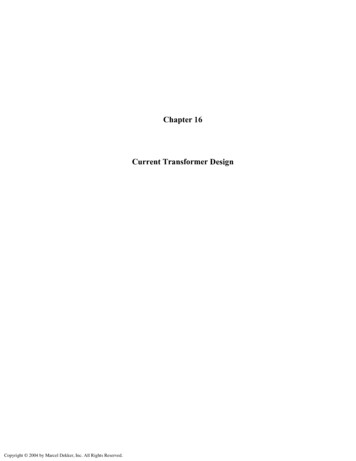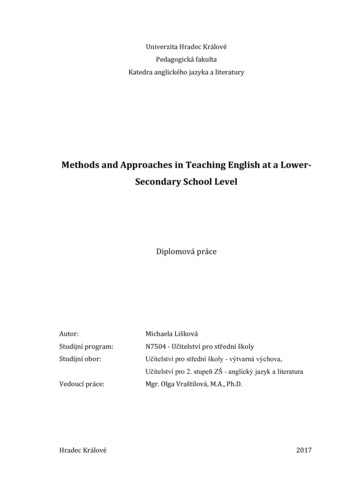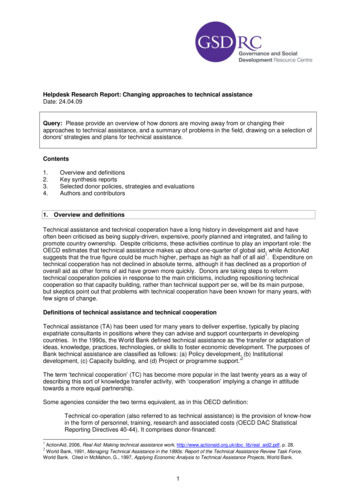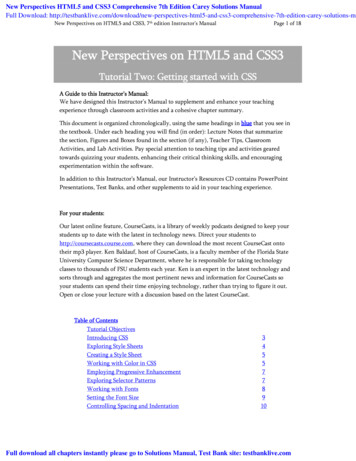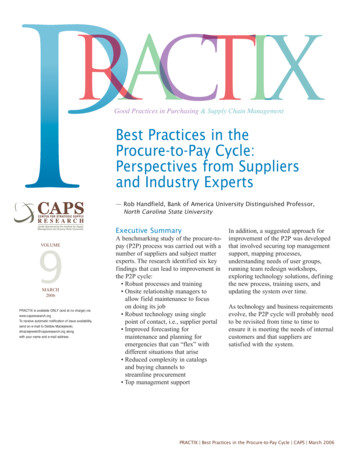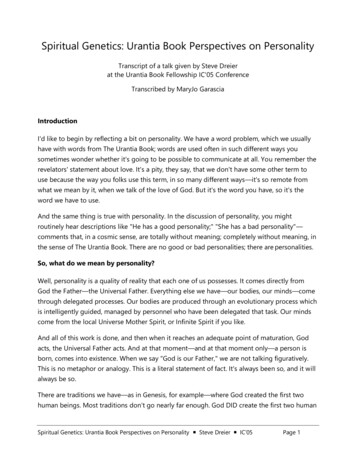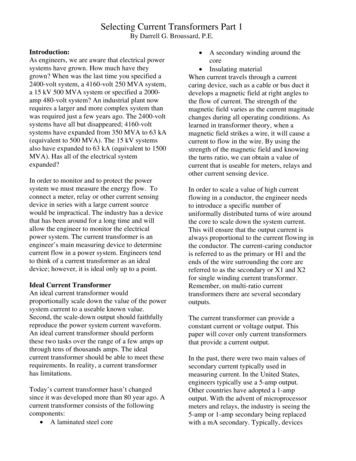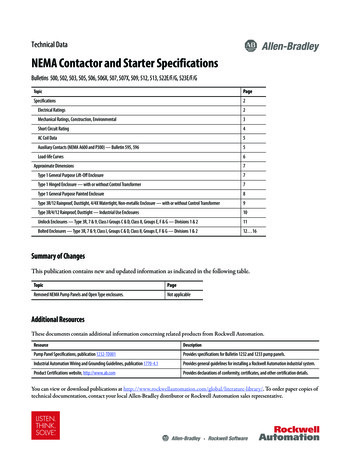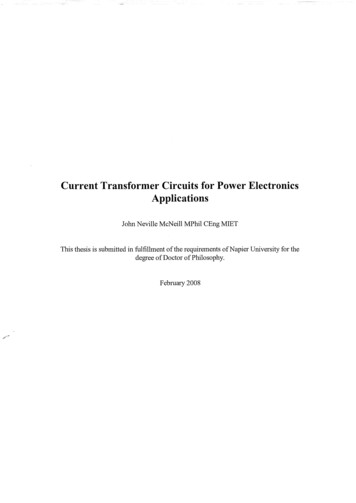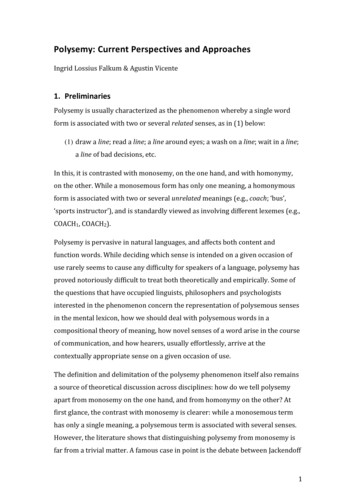
Transcription
Polysemy: Current Perspectives and ApproachesIngrid Lossius Falkum & Agustin Vicente1. PreliminariesPolysemy is usually characterized as the phenomenon whereby a single wordform is associated with two or several related senses, as in (1) below:(1) draw a line; read a line; a line around eyes; a wash on a line; wait in a line;a line of bad decisions, etc.In this, it is contrasted with monosemy, on the one hand, and with homonymy,on the other. While a monosemous form has only one meaning, a homonymousform is associated with two or several unrelated meanings (e.g., coach; ‘bus’,‘sports instructor’), and is standardly viewed as involving different lexemes (e.g.,COACH1, COACH2).Polysemy is pervasive in natural languages, and affects both content andfunction words. While deciding which sense is intended on a given occasion ofuse rarely seems to cause any difficulty for speakers of a language, polysemy hasproved notoriously difficult to treat both theoretically and empirically. Some ofthe questions that have occupied linguists, philosophers and psychologistsinterested in the phenomenon concern the representation of polysemous sensesin the mental lexicon, how we should deal with polysemous words in acompositional theory of meaning, how novel senses of a word arise in the courseof communication, and how hearers, usually effortlessly, arrive at thecontextually appropriate sense on a given occasion of use.The definition and delimitation of the polysemy phenomenon itself also remainsa source of theoretical discussion across disciplines: how do we tell polysemyapart from monosemy on the one hand, and from homonymy on the other? Atfirst glance, the contrast with monosemy is clearer: while a monosemous termhas only a single meaning, a polysemous term is associated with several senses.However, the literature shows that distinguishing polysemy from monosemy isfar from a trivial matter. A famous case in point is the debate between Jackendoff1
(1992a) and Fodor (1998) concerning the English verb keep. Jackendoff arguesthat keep must be polysemous, given that it has different meaning inconstructions such as keep the money, keep the car in the garage, and keep thecrowd happy. Fodor, on his side, argues in favour of a monosemy account of keepin which it means KEEP in all cases, and the apparent difference in meanings issimply an artefact of the different contexts in which the verb appears.Several linguistic tests have been devised to distinguish polysemy frommonosemy. Particularly well known is Zwicky and Saddock’s (1975) identity testby conjunction reduction, where the conjunction of two different senses ormeanings of a word in a single construction gives rise to zeugma. For instance,the verb expire has (at least) the two senses ‘cease to be valid’ and ‘die’, and sothe sentence ?Arthur and his driving license expired yesterday is zeugmatic.Another type of test exploits the impossibility of anaphorically referring todifferent senses (Cruse, 2004a). For instance, in the sentence ?John read a linefrom his new poem. It was straight. the pronoun cannot simultaneously refer to asense of line combinable with the modifier straight (e.g., ‘long, narrow mark orband’) and the sense of line in the previous sentence (‘row of written/printedwords’), which suggests that we have to do with a case of lexical ambiguity.However, such tests for identity of meaning do not give clear-cut answers (for areview, see Geeraerts, 1993). In particular, only a slight manipulation of thecontext can yield a different result, as shown by the following example (Norrick,1981: 115):(2) a. ? Judy’s dissertation is thought provoking though yellowed with age.b. Judy’s dissertation is still thought provoking though yellowed with age.While the sentence in (2a) is zeugmatic – apparently due to the use of Judy’sdissertation to refer to a type of informational content in the first conjunct and aphysical object in the second conjunct – no zeugmatic effect occurs when thesentence is slightly altered as in (2b). Furthermore, the tests typically do notdistinguish between polysemy and homonymy – that is, they do not distinguishbetween senses or meanings that are related and those that are unrelated – both2
of which come out as instances of a more general phenomenon of lexicalambiguity.Many scholars see the distinction between polysemy and homonymy as being oflittle theoretical interest (e.g., Cruse, 1986; Kempson, 1977), and the significantdistinction as being that between lexical ambiguity and monosemy. However,there is recent work in psycholinguistics that suggests that related and unrelatedsenses (or meanings) may be associated with different storage profiles (e.g.,Klepousniotou & Baum, 2007; Rodd, Gaskell, & Marslen-Wilson, 2002), althoughthe results are to some extent conflicting (e.g., Foraker & Murphy, 2012; Klein &Murphy, 2001). An important reason for the different results obtained is thatpolysemy itself is a multifarious phenomenon, and it is not always clear that theexperimental items used across studies are comparable with respect to the formof polysemy they exhibit.Finally, the linguistic tests have also been used to distinguish lexical ambiguity(including homonymy and ‘accidental’ polysemy) from so-called ‘logical’polysemy (see below) (Asher, 2011), on the assumption that the different sensesof a logically polysemous expression can be felicitously conjoined andanaphorically referred to by use of a pronoun. An example of successfulconjunction is the sentence Lunch was delicious but took forever, where lunchrefers consecutively to a type of food and to an event type. An example of afelicitous anaphora is found in the sentence That book is boring. Put it on the topshelf, where the pronoun it refers anaphorically to the physical object sense ofthe noun book, even though the sense of book activated in the previous sentenceis the information sense. In contrast, lexically ambiguous terms give rise tozeugma when conjoined and do not allow for anaphoric reference. Used this way,the conjunction and the anaphoric reference tests seem capable of distinguishingsome types of lexical ambiguity (homonymy and accidental polysemy) fromothers (logical polysemy), but not between logical polysemy and monosemy.It is customary in the literature to distinguish between regular or logicalpolysemy, on the one hand, and irregular or accidental polysemy, on the other3
(Apresjan, 1974; Asher, 2011; Pustejovsky, 1995)1. In a classic paper, Apresjan(1974: 16) described the polysemy of a word A in a given language with themeanings ai and aj as being regular if “there exists at least one other word B withthe meanings bi and bj, which are semantically distinguished from each other inexactly the same way as ai and aj ( ).” Examples in English are terms for animals,which (with some exceptions) can be used to denote either the animal or themeat of that animal (e.g., chicken, rabbit, turkey, etc.), terms for containers usedto denote either the container itself or its contents (e.g., He drank the wholebottle/glass/mug, etc.), names of artists used to denote their works (e.g., Proust ison the top shelf, Mary owns a Picasso) and so on. In formal semantic andcomputational approaches, regular polysemy of this kind is typically analysed asbeing generated by lexical rules, in this way accounting for the productivity andcross-linguistic availability of the patterns of sense extension and at the sametime avoiding a listing of all senses for the words in question (Asher &Lascarides, 2003; Copestake & Briscoe, 1995; Gillon, 1992; Kilgarriff, 1992;Ostler & Atkins, 1992; Pustejovsky, 1995). While this is certainly one way ofaccounting for the regularity involved in this sort of polysemy, there are alsoother, more pragmatically-oriented explanations, which we will discuss furtherbelow.Irregular polysemy, on the other hand, is described by Apresjan (1974: 16) ascases where the semantic distinction between the meanings ai and aj for a wordA cannot be found in any other word of the given language. The English verb runmay be an example of this: its different senses in run a mile, run a shop, run late,run on gasoline, etc. seem idiosyncratic to this particular lexical item, and mayeach have arisen as a result of different lexical semantic or pragmatic processes,such as for instance specification, loosening, metaphorical extension, and so on.However, the distinction between regular and irregular polysemy is not clear-cuteither. As to irregular polysemy, there appears to be degrees of irregularity, withsome cases being clearly idiosyncratic, and others constrained by the waymeaning chains tend to develop (Sweetser, 1990; Taylor, 2003). For instance,It is also possible to distinguish regular from logical polysemy, logical polysemy being asubclass of regular polysemy, which is operationally defined as polysemy which passes theconjunction and anaphoric reference tests (Asher, 2011).14
cognitive linguists have offered exhaustive accounts of the polysemy ofprepositions (see, e.g., Brugman 1988 for a pioneering account of the polysemyof English over) where they bring to light a series of meaning chains, startingwith a preliminary, usually embodied, sense, which extend to new domains insemi-predictable ways. Also, some regular polysemy can be characterized asidiosyncratic or accidental, at least in the sense that it may be idiosyncratic toparticular languages or language communities and its existence seems to be amatter of historical accident. One example may be Nunberg’s (1979) much-citedham sandwich-case, where waiters in a restaurant exploit the pattern ‘meal-forcustomer’ in making reference to their customers (e.g., The ham sandwich wantshis bill). This seems to be an instance of regular polysemy in Apresjan’s (1974)sense, of non-logical polysemy in Asher’s (2011) sense, and could also bedescribed as a case of idiosyncratic polysemy (even though one usually talksabout idiosyncratic and irregular polysemy interchangeably).Recent work on polysemy is as varied as is the phenomenon itself, both in itsfocus and methods. In general linguistics, polysemy received little attention formany years, mainly due to the predominance of generative grammar with itsfocus on the sentence as the central unit of meaning. However, with theemergence of the cognitive grammar during the 1980s polysemy emerged on theresearch agenda as a key topic in lexical semantics, in particular as a result of thepioneering studies conducted by George Lakoff (1987) and Claudia Brugman(1988) on the polysemy of English prepositions. Alongside the cognitivelinguistic movement, polysemy has become a central topic of investigationwithin many formal and computational semantic approaches, starting withPustejovsky’s (1995) seminal work on the topic and most recently culminating inAsher’s (2011) monograph Lexical Meaning in Context. With their focus onsemantic compositionality, these accounts have focused mainly on logicalpolysemy, which seems to be more tractable from a formal/computational pointof view. In addition to these two main trends in the research on polysemy, muchof the work conducted within the relatively new field of lexical pragmatics has adirect bearing on the topic (e.g., Carston, 2002; Recanati, 2004; Wilson &Carston, 2007). These approaches are mainly concerned with how polysemy5
relates to the interaction between linguistically-encoded content and contextualinformation in the derivation of speaker-intended meanings. In thepsycholinguistic literature, polysemy has attracted interest due to the issues itraises for semantic representation, in particular, how the mental lexiconrepresents polysemy compared with homonymy, a distinction that has beeninvestigated using different methods and techniques (e.g., Klein & Murphy, 2001;Klepousniotou & Baum, 2007; Pylkkänen, Llinás, & Murphy, 2006). Finally,recent lexicographical approaches have focused on creating tools for extractingsenses from corpus data (Geeraerts, 2010).Until recently there has been little interaction between these differentapproaches to the study of polysemy. However, we think a common groundbetween them is now emerging, where we are beginning to see the promise ofsome unified treatments, with psycholinguists working with proposals fromcomputational semantics and lexical pragmatics, and theoreticians showingincreased interest in experimental results and psychological models. Thisvolume aims to make advancement in this interdisciplinary line of study bybringing together research done in each of the areas described above. In the nextsection, we will outline the main parameters of the current debate in the new‘common ground’, by focusing on two key questions which – either explicitly orimplicitly – have occupied most researchers working on polysemy: semanticrepresentation and mental storage on the one hand, and the mechanisms ofpolysemy generation on the other. In Section 3, we present a recentlexicographical approach to the study of polysemy.2. Approaches to polysemy representation, storage, and generation2.1. The sense enumeration lexiconThe ‘sense enumeration lexicon hypothesis’ holds that all the different senses ofa polysemous expression are represented in the mental lexicon. That is, there is adistinct representation for each sense of a polysemous word. The model was firstproposed by Katz (1972), it underlies most of the early work in the cognitivegrammar tradition (Brugman, 1988; Brugman & Lakoff, 1988; Lakoff, 1987) andhas lately been advocated by some psycholinguists (Foraker & Murphy, 2012;6
Klein & Murphy, 2001). In this model, the distinction between polysemy andhomonymy is attenuated. Although defenders of the model may distinguishbetween polysemy and homonymy based on whether the different senses ormeanings and thought to belong to a single lexical entry or not, this differencedoes not seem to carry much weight at the level of storage or of processing. Inboth polysemy and homonymy, senses or meanings are thought to be stored asdistinct representations. And when it comes to processing, polysemy resolution,just as homonymy resolution, consists in selecting a sense or a meaning fromwithin a list of distinct senses or meanings associated with the word form.The sense enumeration model is prima facie the simplest way to deal withpolysemy on theoretical grounds. If the aim of semantics is to build acompositional model of linguistic interpretation, then it seems that the leastproblematic option is to postulate that all variability in the semantic contributionof one expression is due to that expression’s having different senses stored asdistinct representations. Speakers and hearers have to select one of these sensesbut once this is done, the compositional process can proceed as normal.However, even from a purely theoretical point of view, the sense enumerationhypothesis turns out to be problematic.First, many words have a large number of different senses. Postulating that thefull range of senses for each word is stored entails a (potentially) indefiniteproliferation of mentally stored senses in order to cover the range of uses ofwords (as an illustration, see Brugman, 1988, who identifies nearly a hundreddifferent uses of the English preposition over). Not only does this place anenormous demand on the storage capacity of the language user, but it also failsto distinguish between those aspects of meaning that are part of the wordmeaning proper and those that result from its interaction with the context, aproblem sometimes referred to as the ‘polysemy fallacy’ (Sandra, 1998). Second,polysemy is pervasive, which means that sentences typically contain severalpolysemous terms. Selection of a sense for one expression would depend on theselection of senses for the rest. If speakers and hearers have to access all thepossible sense combinations for each sentence, then processing just a simplesentence would be costly.7
The sense enumeration hypothesis faces some empirical problems as well. As wehave already mentioned, it does not distinguish between polysemy andhomonymy. However, experimental evidence from psycholinguistics suggest thatwhile the different senses of polysemous expressions prime each other, i.e., theactivation of one sense activates the others as well, homonymy resolutioninvolves competition, rather than priming (Klepousniotou, Titone, & Romero,2008). Furthermore, polysemous expressions whose senses are closely relatedshow a processing advantage in that words with multiple related senses tend tobe responded to faster than words with fewer senses (Azuma & van Orden, 1997;Klepousniotou & Baum, 2007; Rodd et al., 2002). However, if all senses arerepresented distinctly in the mental lexicon, then having more senses should beeither disadvantageous for the speed of response (if the hearer has to access allthe different senses and pick out the relevant one), or have no effect at all (if onlythe relevant sense is accessed). Finally, work done by Steven Frisson with theeye-tracking technique suggests that while homonym resolution seems torequire immediate selection one of the homonymous meanings, polysemyresolution appears to involve the initial activation of an underspecified meaningbefore the reader homes in on the appropriate sense on the basis of the contextthat follows (see Frisson, 2009, for a summary).Recently, however, some psycholinguists have vindicated the sense enumerationmodel on empirical grounds (Foraker & Murphy, 2012; Klein & Murphy, 2001;but cf. Pylkännen, Llinás & Murphy, 2006). Klein and Murphy (2001)investigated the representation of a set of polysemous words using behaviouraltasks. They asked their participants to make a sense/nonsense judgement onphrases containing a polysemous word (e.g., daily paper, shredded paper), andfound that participants were faster and made fewer errors in their sensicalityjudgements when the target phrase had been primed by a phrase using aconsistent sense (e.g., [daily paper], liberal PAPER) than by one using aninconsistent sense (e.g., [daily paper], shredded PAPER), i.e. a consistency effect.The lack of priming effects found for the senses of their polysemous words ledthem to conclude that these were represented in the same way as homonyms.8
In a follow-up study, Foraker and Murphy (2012) present results from an eyetracking study which suggest that not all polysemous expressions arerepresented in the same way: while some polysemes indeed behave ashomonyms, others may require a different approach (see also Klepousniotou etal., 2008). For instance, in the case of paper, the senses appear to be quite distantfrom each other, which may be why they behave much like the meanings ofhomonymous terms (i.e. show signs of competition rather than priming).However, more closely related senses such as the animal and meat senses ofanimal terms (chicken, rabbit, turkey, etc.) seem to prime each other. On Forakerand Murphy’s view, a sense enumeration model might still be able toaccommodate this pattern of results but, as they suggest, “it is possible thatquestions about how senses are activated do not have a single answer but differdepending on the word and the nature of the polysemy” (2012: 424). It could beadded that the question of storage may also depend on the word and the natureof the polysemy.Although the studies by Klein and Murphy (2001) and Foraker and Murphy(2012) provide some experimental evidence in favour of sense enumeration,some methodological problems with their experiments have been pointed out(Klepousniotou et al., 2008). In particular, these concern the experimental itemsused, whose polysemy status is not always clear and contain no distinctionbetween nouns, adjectives and verbs. Frisson (this volume) aimed at replicatingthe experiments by Klein and Murphy (2001) and Foraker and Murphy (2012)using a more controlled set of stimuli, and to test whether sense dominance (i.e.,frequency) could have played a role in the consistency effect found by theseexperiments. Given the evidence that sense dominance affects the processing ofhomonyms, with the more frequent meaning being easier to process than thesubordinate meaning (e.g., Rayner & Duffy, 1986), we should expect to find thesame effect for polysemes if they are represented like homonyms. Frisson’s twoexperiments consisted in a sensicality task (cf. Klein & Murphy 2001) and an eyemovement study (cf. Foraker & Murphy 2012). The stimuli were restricted tonouns that were polysemous between an abstract and a concrete sense (e.g.,book, manuscript, notice, journal, etc.), and where, according to the British9
National Corpus,2 the abstract sense was always the most frequent (i.e.,dominant).First, in the sensicality task, subjects were presented with a prime noun phrasein which the adjective focused on either the concrete (e.g., bound book) or theabstract (e.g., scary book) sense. Then they were asked to make a sensicalityjudgement about a target noun phrase in which the adjective focused on eitherthe consistent (e.g., [well-plotted book], scary BOOK), or the inconsistent (e.g.,[bound book], scary BOOK] sense. The results showed a clear consistency effect,with increased processing time in the inconsistent condition compared with theconsistent condition, but no effect of either sense dominance or direction ofsense switch (concrete to abstract or abstract to concrete) in the inconsistentcondition. While the absence of a processing advantage for the dominant sense isdifficult to accommodate for a sense enumeration theory, the results arecompatible with a relevance theory-inspired view (e.g., Sperber & Wilson,1986/1995; Wilson & Sperber, 2004) which predicts that the disambiguatinginformation provided by the adjective should make processing of either senseequally easy, but that revising an interpretation that has been established asoptimally relevant should be costly.Second, in the eye movement study, subjects were exposed to similarpolysemous words in a regular reading task. There were three conditions: Theneutral conditions aimed at testing how quickly a specific sense is assigned to apolysemous word without prior contextual indication (Neutral-dominant: Marytold me that the book was scary, Neutral-subordinate: Mary told me that the bookwas bound). The repeat conditions aimed at testing the effect of sense repetitionon ease of processing (Repeat-dominant: Mary told me that the science-fictionbook was scary, Repeat-subordinate: Mary told me that the gift-wrapped bookwas bound). Finally, the switch conditions tested whether switching from onesense involves an extra processing cost (Switch-dominant: Mary told me that thebound book was scary, Switch-subordinate: Mary told me that the scary book wasbound). The most important results were as follows: In the neutral conditions,subjects did not have more difficulty disambiguating towards the subordinate2http://www.natcorp.ox.ac.uk10
sense than toward the dominant sense of the polysemous noun. This goesagainst the sense enumeration hypothesis and a relevance theory-inspired view,which would predict that the most frequent sense should be faster to access.3 Inthe repeat conditions, subjects spent more time reading the polysemous nounthan in the neutral condition, but the time to select a particular sense was notaffected by sense frequency. This also goes against both sense enumeration and arelevance theory-inspired view, which would predict faster reading times whena sense has already been accessed than in the neutral condition. Finally, theresults from the switch conditions showed that processing was more difficult inthis context than in the neutral context, and also that switching from asubordinate to a dominant sense induced a greater cost than vice versa, a resultcompatible with both sense enumeration and a relevance theory-inspired view.As an explanation of this asymmetric difficulty, Frisson suggests that readersmight ‘commit’ (Frazier & Rayner, 1990) more strongly to the concrete(subordinate) sense, making it harder to switch to a different interpretation. Thereader might assume that if the writer has made the effort to focus on a lesscommon sense, he should pay more attention to it. Frisson takes the results fromhis eye-movement study to be best explained by a model that takes polysemousexpressions to initially activate an underspecified, abstract representation whichencompasses all its established senses (in the present case this would includeboth the content and the physical object senses), and where context is then usedto ‘home in’ on the intended sense (see, e.g., Frisson, 2009). In the followingsection, we discuss this option in more detail.2.2. The one representation hypothesisThe main alternative to the sense enumeration lexicon hypothesis is the socalled ‘one representation hypothesis’. According to this hypothesis, the sensesFrisson’s use of the notion ‘relevance theory-inspired view’ reflects the fact that the predictionsfrom actual relevance theory often cannot be stated in general terms like this, but may depend ona number of factors. One important factor in the present context is whether the book type ofpolysemy is hypothesised to involve a single concept or distinct concepts. If distinct concepts, weget the predictions that follow from Frisson’s relevance theory-inspired view for the relationbetween dominant-subordinate senses in the neutral and repeat conditions. But if there is only asingle concept associated with the book type of polysemy, which seems to be the dominant viewin the literature (e.g., Cruse, 1986; Falkum, 2011; Nunberg, 1979; Pustejovsky, 1995), thepredictions of relevance theory are likely to be very similar to those made by Frisson’sunderspecification hypothesis (see below).311
of a polysemous expression either belong to or depend on a singlerepresentation. The hypothesis that the different senses of a polysemousexpression depend on a single representation is clearly more cautious than theclaim that they belong to, i.e. are stored as part of, a single representation. In fact,most researchers who defend the one representation hypothesis espouse thismore moderate claim. The general idea is that, when interpreting a polysemousexpression, competent speakers access a semantic representation which acts as agateway to the different senses. There are different ways to cash out thisproposal, ranging from the decompositional account of Pustejovsky (1995),where senses are generated on the basis of informationally rich lexicalrepresentations, to Carston’s (2012) recent proposal that the representation thatspeakers first access in encountering a word may simply embody someconstraints on what the word may express (cf. ‘pointers to a conceptual space’,Carston, 2002).In recent years, psycholinguists have debated two proposals that fall under theone representation approach, ‘the core meaning hypothesis’ and ‘theunderspecification hypothesis’. However, it is not clear how much these twohypotheses differ, since their more concrete commitments still remain to bespelled out. We think that the core-meaning approach can be understood as akind of underspecification approach, and in what follows we will treat it thatway.Underspecification accounts have been proposed to deal with a variety ofphenomena, including scope ambiguities (Egg, 2011) and alleged type-shiftingconstructions (de Almeida & Dwivedi, 2008). The underspecification approach topolysemy holds that hearers, when encountering a polysemous expression, donot opt for a particular sense but rather access an underspecified representationwhich is enriched only if required by the context. This hypothesis has beendefended by Steven Frisson in a number of papers (for a review, Frisson, 2009),although he is not very specific about what exactly the hypothesis amounts to.According to Frisson, it is compatible with views as different as Pustejovsky’s(1995) generative lexicon (more specifically, his notion of qualia structures),Carston’s minimalist proposal (2012), as well as the core meaning approach12
holding that the representation accessed is some abstract meaning that is sharedby all the different senses of a polysemous word (Ruhl, 1989). In our view, themost important difference between these three options lies in what we can call‘thin’ and ‘rich’ semantics, i.e. between minimalist and core meaning proposalson the one hand, and accounts inspired by Pustejovsky’s rich lexicalrepresentations on the other hand.2.2.1. Thin semanticsLet us start with ‘thin semantics’. Thin semantics is the view that lexical, orstanding meanings of words are impoverished with respect to their occasionalmeanings (i.e. the meanings they express on a certain occasion of utterance,which is their contribution to the truth-conditions of the sentential utterance).This view has a long tradition (see Maienborn, 2011), and has recently gainedmomentum by being associated with contextualist approaches and the so-called‘semantic underdeterminacy thesis’ (Carston, 2002), according to which thesemantic content of a sentential utterance underdetermines its truth-conditionalmeaning. Although the thesis is compatible with different views on lexicalmeaning, one natural approach is to postulate a thin semantics, according towhich lexical meanings only contain information which constrains the range ofconcepts that words can be used to express (Carston, 2012; Travis, 2008), orprovide semantic potentials, which may be summary representations of pastuses of words which guide new uses (Recanati, 2004).These versions of the underspecification view suggest a discontinuity betweenunderspecified semantic representations and the concepts word-tokens express.Other proposals in the thin semantics camp do not posit this kind of separation.For instance, Bierwisch and Schreuder (1992) distinguish between semantic andconceptual representations, where semantic representations are taken to consistof sets of
(Apresjan, 1974; Asher, 2011; Pustejovsky, 1995)1. In a classic paper, Apresjan (1974: 16) described the polysemy of a word A in a given language with the meanings a i and a j as being regular if there exists at least one other word B with the meanings b i and b j, which are semantically dis

